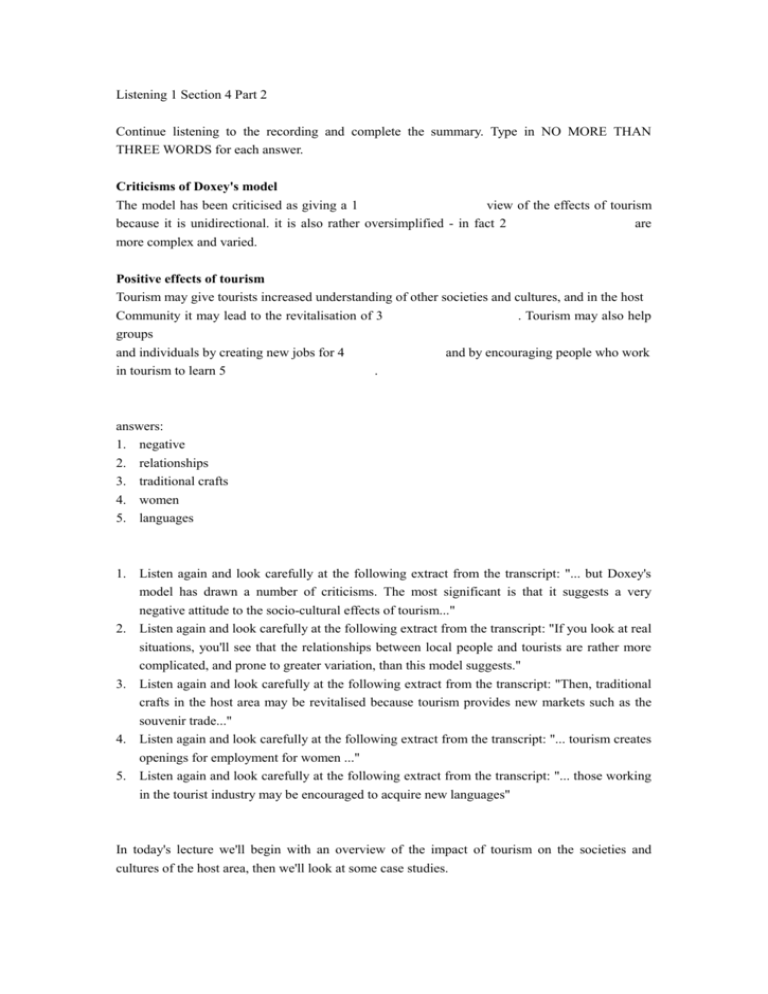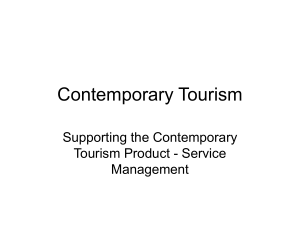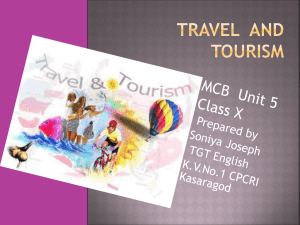Listening 1 Section 4 Part 2 Continue listening to the recording and
advertisement

Listening 1 Section 4 Part 2 Continue listening to the recording and complete the summary. Type in NO MORE THAN THREE WORDS for each answer. Criticisms of Doxey's model The model has been criticised as giving a 1 view of the effects of tourism because it is unidirectional. it is also rather oversimplified - in fact 2 are more complex and varied. Positive effects of tourism Tourism may give tourists increased understanding of other societies and cultures, and in the host Community it may lead to the revitalisation of 3 . Tourism may also help groups and individuals by creating new jobs for 4 and by encouraging people who work in tourism to learn 5 . answers: 1. negative 2. relationships 3. traditional crafts 4. women 5. languages 1. Listen again and look carefully at the following extract from the transcript: "... but Doxey's model has drawn a number of criticisms. The most significant is that it suggests a very negative attitude to the socio-cultural effects of tourism..." 2. Listen again and look carefully at the following extract from the transcript: "If you look at real situations, you'll see that the relationships between local people and tourists are rather more complicated, and prone to greater variation, than this model suggests." 3. Listen again and look carefully at the following extract from the transcript: "Then, traditional crafts in the host area may be revitalised because tourism provides new markets such as the souvenir trade..." 4. Listen again and look carefully at the following extract from the transcript: "... tourism creates openings for employment for women ..." 5. Listen again and look carefully at the following extract from the transcript: "... those working in the tourist industry may be encouraged to acquire new languages" In today's lecture we'll begin with an overview of the impact of tourism on the societies and cultures of the host area, then we'll look at some case studies. One model for the socio-cultural impact of tourism has been provided by Doxey - you'll find a reference in your reading list. He called his model the 'Irridex' - that's a contraction of 'irritation index' and it attempts to show how the attitudes of local people to tourists and tourism change over the years. Doxey identifies four stages. He calls the first stage Euphoria - happiness - because initially the tourists are regarded as a novelty, and because of this they're welcomed by everyone in the host area. But as well as that, there's another reason for the people in the host community to welcome tourists: local people realise that tourism brings scope for economic benefits. As tourist development begins to increase, however, local interest in the visitors becomes sectionalised. That means that some sections of the local population become involved with tourists while others don't, and it is increasingly the case that commercial rather than social factors are influencing relationships between tourists and the host community; people are less interested in the tourists for their own sake. Doxey calls this stage Apathy. If development continues to increase, apathy may change to Annoyance. What's causing this? Well, development of the tourist area may start to spiral up out of control, and this is often accompanied by congestion, which is going to make life difficult for local people. So the policy makers, the government, the local authorities, and so on, provide more infrastructure for the area - more roads, more car parks and so on - to try to help cope with the influx of tourists. But the lives of the local people are made increasingly difficult and in the final stage of the model, annoyance has turned to Antagonism and open hostility to the tourists, and now all the detrimental changes to lifestyles in the host area are, fairly or unfairly, seen as due to the tourists. Well, this sort of pathway is certainly a fairly good reflection of what happens in some tourist destinations, but Doxey's model has drawn a number of criticisms. The most significant is that it suggests a very negative attitude to the socio-cultural effects of tourism - the fact that the model is unidirectional, that it only works in one direction, seems to suggest that decline in the host-visitor relationship is inevitable. Now in practice, fortunately, things aren't always quite like that. If you look at real situations, you'll see that the relationships between local people and tourists are rather more complicated, and prone to greater variation, than this model suggests. So the model is really rather oversimplified. In fact, studies have highlighted quite a few positive effects of tourism. For example, Doxey's model doesn't look at the effects on the tourists themselves - they may well benefit from increased understanding of the host society and culture. Then, traditional crafts in the host area may be revitalised because tourism provides new markets such as the souvenir trade, for example, so instead of these traditional skills being lost, local people are encouraged to develop them. There may also be more long-lasting changes, which actually lead to the empowerment of both groups and individuals in the host area. For example, tourism creates openings for employment for women, and through giving them a chance to have a personal income, it allows them to become more independent. In addition, because tourism tends to work through a very few languages that have world-wide usage, those working in the tourist industry may be encouraged to acquire new languages, and this will empower them through providing wider access to globalised media, and improving their job prospects in a wider context. Right, now we'll take a short break there and then we'll look at a couple of case studies and see how far the points we've discussed so far apply to them.






